[ Read my product review disclosure statement here.]
 When it comes to style, Apogee hardware is in a class by itself. When Roger Robindoré, Director of Product Evangelism at Apogee Electronics Corp., asked if I wanted to review the Duet, I knew it would be a stylish-looking piece of hardware, so I said “Yes!” immediately.
When it comes to style, Apogee hardware is in a class by itself. When Roger Robindoré, Director of Product Evangelism at Apogee Electronics Corp., asked if I wanted to review the Duet, I knew it would be a stylish-looking piece of hardware, so I said “Yes!” immediately.
EXECUTIVE SUMMARY
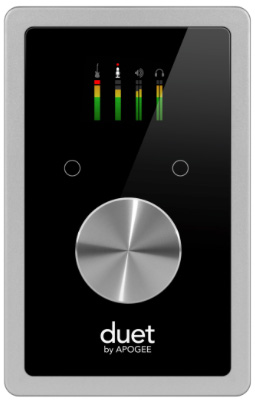
The Apogee Duet is a stylish, AD/DA audio converter that provides 2 analog inputs with mic preamps and selectable 48 volt phantom power for connecting microphones, instruments or line-level devices; 4 analog outputs including 2 balanced 1/4” outs for speakers or outboard gear, 1/4” stereo headphone output; a USB 2 connection to connect to a Mac; a MIDI port; and a digital connection for iOS devices.
Apogee units are pricier than similar interfaces from companies like Edirol, Steenberg, ProSonus; however the Apogee claim to fame is outstanding audio quality and great build quality.
I found the Duet easy to setup and configure. The controls and the built-in screen simplify adjustments and the Duet looks great on the desktop. The only downside is that the Duet costs about twice as much as competitive units.
A big benefit of the Duet is that it works on both Mac and iOS devices giving you the ability to capture high-quality audio on your phone.
To help you decide whether the improved audio quality justifies the price, I’ve included a high-quality audio comparison.
Product: Apogee Duet
Manufacturer: Apogee Electronics, Corp.
Website: www.apogeedigital.com/products/duet
MSRP: $649 (US)
WHAT DOES DUET DO?
In order to record a microphone or analog musical instrument, we need to convert the analog signal into something the computer can read. Conversely, in order to hear audio stored on our computer or iOS device on something other than the built-in speakers, we also need to convert the ones and zeros of the computer into something our speakers can play.
In fact, we use a lot of these converters in our editing suites and studio to either record microphones or feed computer audio to speakers. In looking around, I see we are using units from:
This conversion process is called A/D (Analog to Digital) or, in the case of the Duet, AD/DA (Analog to Digital, then, Digital back to Analog). As with any conversion process, something is always lost in the conversion, so the goal of all audio converters is to provide the highest quality conversion which does the least damage to your audio in the process.
If all your music is generated on the computer and you listen to all your work on headsets, you won’t need this. However, for most of the audio world, high-quality audio converters are used every day.
INSTALLATION
In the box is:
NOTE: The power adapter is only needed when you are using the Duet with an iOS device.
In order to use Duet, you need to download the software installer from the Apogee website. Apogee updated their drivers in June, 2015, to support OS X 10.11, 10.10 and 10.9. The installer requires first updating the firmware in the Duet (which was not necessary in my case), then installing the software. A computer restart is required after installation.
NOTE: You can also connect this to an iOS device using a Lighting connector. The User Guide explains how to download the Maestro software needed by Duet from the iOS App Store. The operation of the Duet is the same.
The entire installation process took about five minutes, including the download and computer restart.
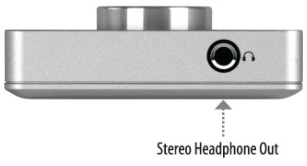
Here are the connectors at the top of the unit (source: Apogee).

Here are the connectors at the bottom of the unit (source: Apogee).
CONFIGURING AUDIO SETTINGS
After the restart, a dialog appears asking to register the Duet. I always recommend registering hardware and software. If there’s an update or a problem, registration gives the developers a way to contact you.
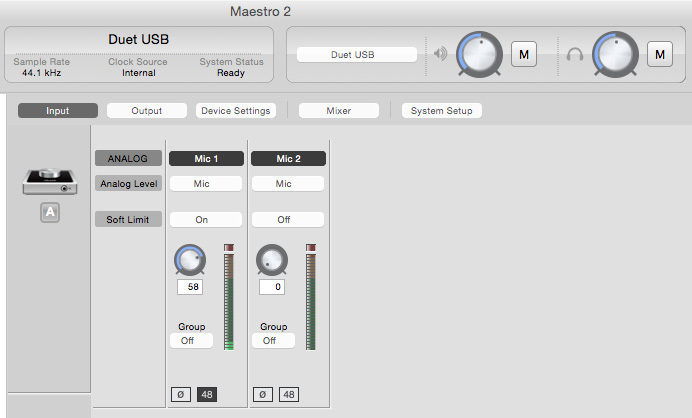
To enable the Duet, we first need to start Apogee Maestro (which is installed withDuet).

I turned Channel 1 on, set the popup menu to Mic and enabled Phantom Power. Because I was only doing a single mic test, I turned channel 2 off.

NOTE: I am puzzled that the Duet defaults to 44.1 kHz sample rate for input; and I could find no way to change this. At a minimum, I would have expected a 48kHz sample rate, which is the default setting for video. The Duet specs indicate conversion is at 24-bit/ 192 kHz sample rate – both of which are excellent, but apparently inaccessible.
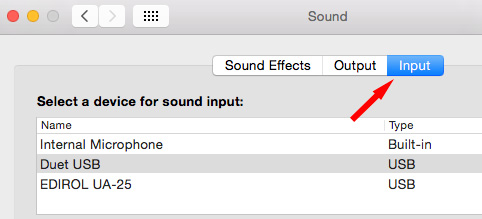
To enable the Duet, open Macintosh > System Preferences and set Duet as the default Audio Input and Output.
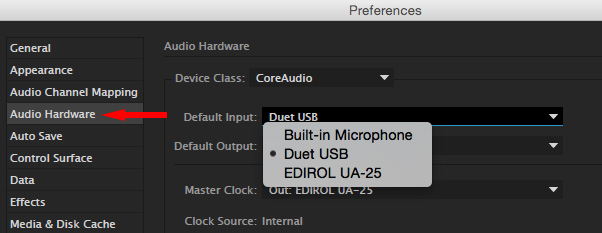
For my audio test, I wanted to record directly into Adobe Audition. (The Setup Guide includes instructions for using Duet with Logic, ProTools, Ableton Live and iOS apps.) To configure the Duet for Adobe Audition, open Audition’s Audio Hardware preferences and change the Default Input and Default Output settings to the Duet.
AN AUDIO TEST
The audio system I currently use for all my video training connects an AKG-520c headset mic into an Aphex Master Voice Processor which goes into an Edirol UA-25 AD/DA, which is then recorded using either Adobe Audition (audio-only) or Telestream ScreenFlow (screen-captures).
My on-camera studio work uses an Electro-Voice RE-20 fed into a Behringer X32 Producer audio console, then recorded to an SSD.
I decided to use these two mics and compare the quality of the Edirol with the Duet and share the recording with you so you can judge quality for yourself.
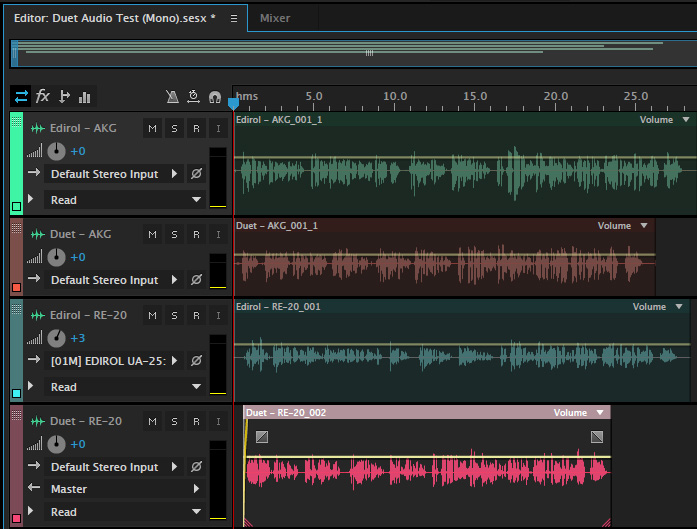
Here’s what the recordings looked like in Audition.
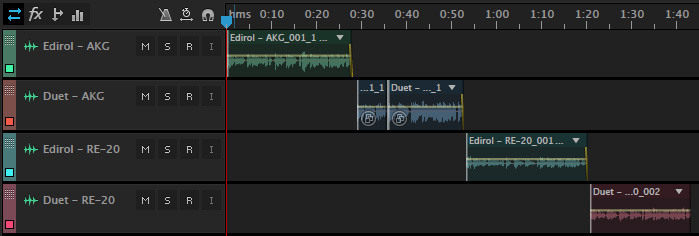
And here’s the layout of the final audio file.
AUDIO TEST RESULTS
Here are the recordings I made during my test saved in an audio file that runs about a minute and a half. Take a listen and see if you can hear a difference. (All audio is uncompressed. All I did in Audition was adjust levels so all clips played evenly. No filters or other audio processing were used.)
As an aside, computer speakers are not good for judging audio quality; headsets or monitor speakers would yield better results.
AUDIO SPECS: WAV audio, 48 kHz sample rate, 32-bit.
NOTE: I’m purposefully not making any quality judgements about the Duet simply because my hearing is not as good as I would like.
LARRY’S THOUGHTS
My first reaction as I was recording was that the Duet has a lot more amplification built into it and I love the smooth operation of the master control knob. I also liked the small audio meters built-into the Duet’s display. These mean I can quickly set a level without opening an audio application; this is very helpful when I am recording to ScreenFlow.
The Apogee Duet features world-class construction with dead-easy operation and made by a company that’s obsessed about audio quality. Even better, after you get it setup, you pretty much leave it alone and admire the blinking lights.
It looks simply stunning sitting on your desk.
My only hesitation is that its price puts it far above the competition. If you regularly create audio that needs to be top-quality and is played without compression, then the Duet was designed for you.
If your audio is destined for the web after undergoing serious audio compression, you may not be able to hear the difference in the final output.
Listen for yourself and let me know what you think.
2,000 Video Training Titles
Edit smarter with Larry Jordan. Available in our store.
Access over 2,000 on-demand video editing courses. Become a member of our Video Training Library today!
Subscribe to Larry's FREE weekly newsletter and
save 10%
on your first purchase.
4 Responses to Product Review: Apogee Duet
Great review, Larry. For the money though, I think the Universal Audio Apollo Twin might be a better investment. Info here: http://www.uaudio.com/interfaces/apollo-twin.html
and here (duo) http://www.bhphotovideo.com/c/product/1024094-REG/universal_audio_aptwd_apollo_twin_w_duo.html
(solo) http://www.bhphotovideo.com/c/product/1024094-REG/universal_audio_aptwd_apollo_twin_w_duo.html
I’m looking into the Solo version myself but for $200 more I might get the Duo version. I really like that it has Thunderbolt connectivity.
Regarding sample rate changes, you can easily change the Duet’s sample rate using Apple’s Audio Midi Setup. In the Audio Devices panel, select the Input tab and you’ll see a popup for sample rate when the Duet is selected. I see six choices, running up to 196khz, including 48k.
Regarding expense — I know the price is high compared to the obvious competition. What may not be obvious is that I don’t think it’s a fair comparison if your need is for studio quality D to A conversion for driving studio monitors with uncompromised audio. In that, I believe the Duet is a leader of cost to quality. We’ve run critical listening tests on the competition that offer super clean D to A and A to D — all of which costs as much or more, usually a lot more, and the Duet holds up great. The cheaper stuff is fine for web work and casual listening, but if your goal is studio quality, the less expensive converters fall short in our view.
Duet A/D is far more appealing, present, and clear to my ear. It’s as if I’m hearing the air around you with a tinge of brilliance I like. Super natural, as is their ONE Mic, which does better narration at about 8 inches than Neuman M149 (Tube Sounding), and many other A/B test I’ve done. Apogee has had that glean of beautiful clarity and presence for many years now. I just can’t believe they’ve ended up putting all that quality I paid about $5000 for their full studio version A/D converters several years back. Amazing ears somewhere in that company.